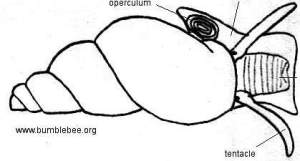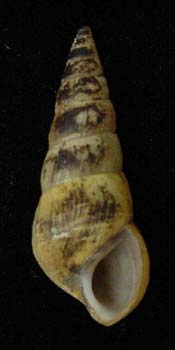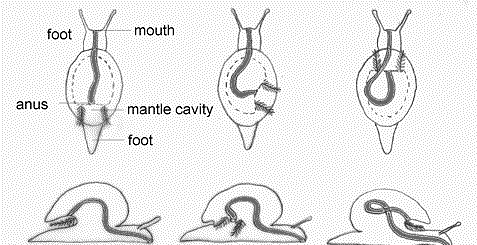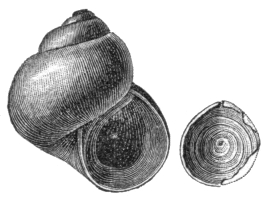General Body Structures:
Shell:

The shell is a form of external skeletal structure for several
animals, it serves as an important protective covering, weight support structure, and
attachment site for muscles (Hickman,
2009). Exoskeletons are characteristic of
Arthropods and Mollusks. In
mollusks, the shell continues
to grow as the organism increases in size, eliminating the need
to molt (Hickman, 2009). This adaptation comes
with both benefits and downfalls. One benefit is the avoidance
of vulnerability and energy costs associated with
molting. During molting, an organism is in an extremely
vulnerable state, and must spend much of its energy to molt and
create a new shell (Hickman, 2009). The downfall of not molting is that
the organism must dedicate some of its daily energy resources to
building a new larger shell. If resources are limited or
the snail somehow cannot regenerated new shell, their body size
is limited (Hickman, 2009).
 Shell
Coiling:
Shell
Coiling:
The shell of Pleurocera acuta varies in color from pale to deep
brown averaging 29.9 mm long and 11.3 mm wide
(Dazo, 1965). The shell of
Pleurocera acuta is related
to other Gastropods by having torsion, the
twisting of internal body cavity 180 degrees so that the anus is
in the same opening as the mouth
(Hickman, 2009). Pleurocera acuta also
shares the characteristic of having a single shell that is
coiled. Coiling, also known as spiral winding of the
shell, is a separate characteristic that evolved before torsion
(Hickman, 2009). Each
separate spiral can also be referred to as a whorl
(Benson, 2011). Pleurocera acuta can contain anywhere from 9 to 14 whorls
(Benson, 2011). According to research
referenced by Hickman, early
Gastropods had bilateral symmetry but have evolved to shift
their shells posterior and upward for a more balanced body
structure. Still,
the weight of the first whorl was distributed unevenly to the
right side of the body resulting in the gills, auricle, and
kidney organs of that side being lost. Because of this
Pleurocera acuta and similar Gastropods are classified as
having bilateral asymmetry (Hickman,
2009).
Shell Torsion:
Torsion is also present in the body structure of Pleurocera acuta.
Torsion is an evolutionary characteristic that distinguishes
Gastropods from the other
Mollusk groups
(Hickman, 2009). Torsion is the
twisting of the internal body structure 180 degrees so that the
anus is located anterior to the head
(Hickman, 2009). This adaptation is thought to be
created for protection by decreasing the weak openings to the
inside of the shell. As a result of
torsion the left gill, kidney, and heart atrium move from the
left to the right side of the body and the nerve cord is twisted
to form a
figure eight (Hickman, 2009). But this arrangement brings with it a
set of obstacles to overcome, the major one being fouling.
Fouling is the presence of waste washing over the gills and
contaminating the body cavity (Bay,
1999). To avoid fouling snails have
developed some interesting tactics. The first comes from the
sensory system of the snail. Sensory organs in the mantle
cavity called osphradia sense the direction of the water
currents so that the waste is drawn away from the head when
released (Dazo, 1965; Hickman, 2009).
The snail also possesses two independent incurrent
and excurrent water siphons that are separated by space
(Hickman, 2009). Another
adaptation that can also be coupled with coiling is the loss of
the right gill, which creates a one way path for water
through the body (Hickman, 2009). Water enters the incurrent siphon on the left
side of the mantle cavity and out the excurrent siphon on the
right side (Hickman, 2009).

Mantle:
The mantle is a thin, white, almost transparent layer of tissue
that acts as a buffer between the hard protective shell and the
soft inner visceral mass of Pleurocera acuta
(Hickman, 2009; Dazo, 1965). It is well supplied with blood
vessels and nerves and contains the gills, osphradium, and anus
(Dazo,
1965). One of the most important functions of the mantle
is to secrete a layer that will form the shell
(Hickman, 2009).
Shell Layers:
The shell is made up of three distinct layers. The innermost
layer is called the nacreous layer. It is iridescent in
color and composed of calcium carbonate which is secreted by the mantle
(Hickman, 2009). The middle layer is the prismatic
later which is composed of calcium carbonate crystals in a
protein matrix (Hickman, 2009). The outermost layer is called the periostracum. It is
pigmented and
composed of a protein called conchin which gives it strength and
resistance to dilute acidity (Hickman, 2009).
 Operculum:
Operculum:
The operculum is a characteristics specific to the
Gastropod subgroup Prosobranchia
(Hickman, 2009). The
operculum acts as a type of door to the shell. It protects
the visceral mass from external elements by holding water and
other nutrients inside for extended periods of time
(Hickman, 2009).
The operculum of Pleurocera acuta is reddish brown oval structure made of chiton
that consists of three whorls in adults
(Hickman, 2009; Dazo, 1965).
In a study done by B.C. Dazo, it was noted that some of the
snails lost their operculum's because of parasites. Once lost,
the operculum was regenerated completely in three to four months
(Dazo, 1965).